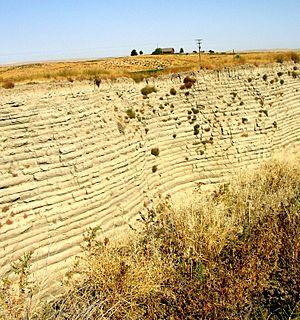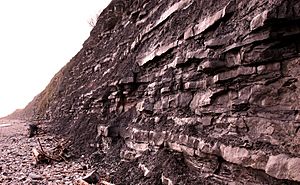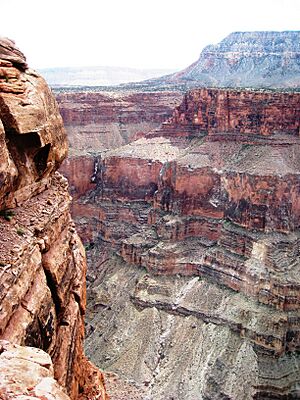Rhythmite facts for kids



A rhythmite is a special type of rock or sediment that shows layers laid down in a repeating pattern. Think of it like stripes that repeat over and over again. These patterns can be caused by things that happen regularly, like the seasons changing or tides moving.
Some rhythmites show patterns that repeat every year. These are called varves. Other rhythmites show patterns that take much longer to form, sometimes thousands or even millions of years!
Contents
What Rhythmites Tell Us About Earth's Past
Rhythmites are like a history book written in stone. They can show us about big events that happened long ago, before humans were around.
Clues from Climate Change
Many rock layers show repeating patterns. For example, you might see layers of clay alternating with layers of sandstone. Or, layers of carbonate rock might switch with layers of shale.
This often happens because of repeating climate cycles.
- During warmer times, the sea level rises. In shallow, warm seas, rocks like limestone (a type of carbonate rock) are formed.
- Later, if ice builds up at the Earth's poles, the sea level drops. The same area might then be closer to the shore. This allows sand and mud from rivers to be deposited instead.
Patterns on Land
Even deposits on land can show these patterns. A low-lying area might become a lake or a swamp during wet periods. But during dry periods, it could turn into a desert or a mudflat.
When it's dry, erosion (wearing away of rock) happens more. When it's wet, new sediment is deposited. This creates the repeating layers we see.
Volcanic Rhythmites
Not all rhythmites are caused by climate. In areas with volcanoes, layers of rock in lakes can be regularly interrupted by eruptions of volcanic ash. So, you might find layers of shale and mudstone alternating with layers of tuff (rock made from volcanic ash).

Images for kids
-
Pleistocene age varves at Scarborough Bluffs, Toronto, Ontario, Canada. The thickest varves are close to 2 cm thick.


